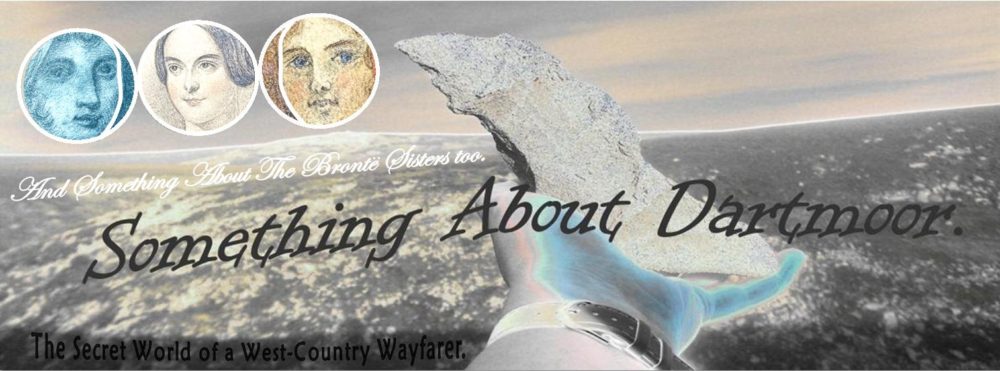Updated: Monday, 6th May 2019.
Some more ‘Bonnet’ vibes from ‘Something About Dartmoor’; in the name ‘Dart’ is the word ‘Art’!!!
This time round my trusty magnifying glass is hovering over the ‘Blue version’ of the ‘Bonnet Portrait’…
First and ‘foremost’ – ‘Emily’ has a MINUSCULE date for 1837 – nestled in the drapery of her cloak. To the unaccustomed eye they look like a row of four black dots that ARE in fact numbers – individually no bigger than a millimetre high. They are THAT small——nay smaller, too small to measure accurately while holding a magnifying glass and a ruler!
The date ‘1837’ confirms that this painting was painted well within Charlotte’s lifetime 1816 to 1855 – and Emily’s lifetime too——1818 to 1848.

The highlighted area holds the date ‘1837’ – four tiny black numbers in black ink – on inky-blue watercolour paint. If only someone such as Professor Aviva Burnstock from ‘The Courtauld Institute of Art’ could take a look at it! I’ve written to the BBC’s [Fake or Fortune?] several times alerting them to these ‘lost’ artworks by Charlotte but alas nothing…

It’s minuscule! The eagle-eyed (or raven-eyed in my case) may just be able to perceive the number shapes. It’s a digitally ‘enhanced’ close-up of a minute date – ie the contrast and light has been altered only. Unfortunately one loses detail in order to try and bring out detail; come on Aviva – ‘Emily’ needs your expertise!!!

The pencil version and the ‘Blue’ version both share a distinctive shoulder ‘squiggle’ – or the cryptic ‘L’ in ‘E.M.I.L.Y’ in five bold pencil strokes from left to right in the drapery of her cloak in the pencil version. Click on images to enlarge in a separate window.

’37’ again – as in 1837 – ‘lost’ in the drapery. Confirms the ’37’ in the minuscule date. Interestingly, it’s a ‘French Seven’ with a fancy line through it. (Standing back from this image is helpful if one has trouble perceiving the numbers inside the ‘cloud’.)
The ‘Blue’ version is almost identical in style to an authenticated portrait by Charlotte in the Brontë Parsonage Museum collection called, ‘The French Brunette’ – listed as No. 93 in ‘The art of the Brontës’. Click ‘HERE’ or on the title link above – to see a relatively clear image of ‘The French Brunette’ courtesy of Pinterest——and the Brontë Society!
The blue’ version of the ‘Bonnet Portrait’ measures 157 x 131 mm – ‘The French Brunette’ measures 162 x 129 mm as stated in ‘The art of the Brontës’…

And then there are Charlotte’s rows and rows of secret numbers – or ‘magic numbers’ as I think of them. It is something that all three ‘Bonnets’ have in common; the miniature version, the pencil sketch version – and the blue version – as exposed above in an area of Emily’s straw hat. I wonder what the number sequences could mean? – or are they completely random? as a way of shading.
The Brontës were interested in Numerology; hence I have noticed hidden numbers appear in many other Bronte drawings and paintings, especially in Charlotte’s, Emily’s and Branwell’s. I can’t find a reference to hidden numbers in ‘The art of the Brontës’ – the catalogue raisonné – or anywhere.
Below is another ‘cloud-shaped’ one-liner – ie. clue – “On verso: rough pencil outline tracing of the figure on recto.”…

Some more cloud-shaped thinking courtesy of ‘The art of the Brontës’ – a truly GREAT tome! Mine is stuffed with my notes. (The image above “Young woman in peasant dress…” is ‘The French Brunette’ by Charlotte.)
The ‘Baby Bonnet’ also shows a “rough pencil outline tracing of the figure on recto”…
 The ‘blue’ version of the ‘Bonnet Portrait’ and ‘The French Brunette’ look very alike in technique too…
The ‘blue’ version of the ‘Bonnet Portrait’ and ‘The French Brunette’ look very alike in technique too…
“The handling of paint for the skin shows Charlotte’s painstaking technique of using tiny daubs of grey paint as in stippling…” from ‘The Art of the Brontës’ by Christine Alexander and Jane Sellars – page 212.

The colour of Emily’s eyes “Their colour might be said to be dark grey, at other times dark blue, they varied so.” Reminiscences of Charlotte Brontë. Ellen Nussey.
Then there are the shared streaked backgrounds, the same rich auburn-brown hair, the same ‘outlines’ and painted-over edges ie. alterations – the use of gum Arabic…

The eyes have IT! A transparent glaze of ‘gum Arabic’ has been applied by Charlotte to give greater depth and clarity – and shine.
Just check-out the execution of the ringlets on the right of Emily’s face (above) – then click on ‘The French Brunette’ again…

Some eye studies by Charlotte on display in the Bronte Parsonage Museum in 2017 – that caught my eye…

The portrait in its original Verre églomisé frame. The process of back-painting and gilding glass to give it a mirror-like finish – is called, Verre églomisé – a french term dating from the 18th century.

The photogravure reproduction as it appears in the ‘Woman at Home’ 1894. The Editor of the ‘Woman at Home’ was one Sir William Robertson Nicoll – the person that witnessed the original lost portrait of Emily Bronte by Charlotte Bronte in Haworth in 1879, when he paid a visit to the Bronte’s housekeeper, Martha Brown. After Martha’s death in 1880 the portrait of Emily by Charlotte became ‘lost’ despite William Robertson Nicoll’s best efforts to find it. The original portrait was last seen in 1879 by Nicoll.
Late walk Sunday, 20th.January 2019…















